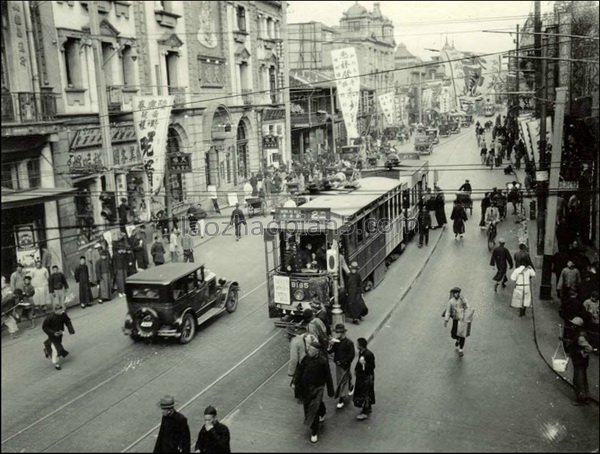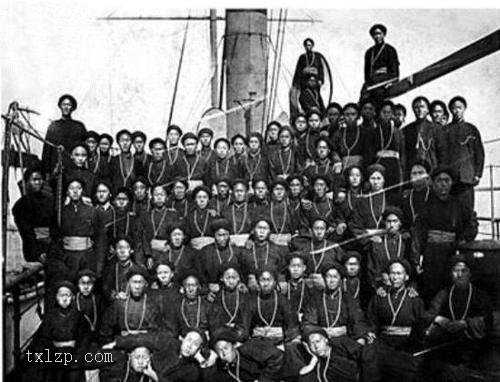Period:Unknown Production date:4thC-5thC
Materials:fired clay, stucco, 粘土 (Chinese), 灰泥 (Chinese),
Technique:mould-made, slipped, painted,
Subjects:buddha 佛 (Chinese)
Dimensions:Height: 23.50 centimetres Width: 17.40 centimetres
Description:
Fragment of a clay figure. This is the head of the Buddha, shown with closed eyes and a serene facial expression. The figure is much damaged and the top-knot as well as the right ear have broken off. However, some of the curls are still visible. The figure was made using a mould and covered with a red slip before being fired. Traces of white and black paint also remain.
IMG
![图片[1]-figure; 畫像(Chinese) BM-1907-1111.174-China Archive](https://chinaarchive.net/Unknown/43/mid_01144232_001.jpg)
![图片[2]-figure; 畫像(Chinese) BM-1907-1111.174-China Archive](https://chinaarchive.net/Unknown/43/mid_01144234_001.jpg)
![图片[3]-figure; 畫像(Chinese) BM-1907-1111.174-China Archive](https://chinaarchive.net/Unknown/43/mid_01144235_001.jpg)
![图片[4]-figure; 畫像(Chinese) BM-1907-1111.174-China Archive](https://chinaarchive.net/Unknown/43/mid_00013089_001.jpg)
Comments:EnglishFrom Whitfield 1985:The great stupa at Rawak was one of the most important sites investigated by Stein on his first journey. Lying to the north of Khotan, high sand dunes helped to preserve it while subsoil water had destroyed the timbers that served to support its sculptures. The plan (see Ancient Khotan, Pl.XL) shows a vihāra court 161 feet (49.1 m)long by 141 feet (43.0m)wide, within which rose a stupa in three storeys, the lowest some 78 feet (23.8m)square. The stupa was approached by a staircase in the centre of each side; its summit, as measured by Stein, was some 23 1/2 feet (7.1m) above the floor of the court. The enclosing wall of this vihāra court was adorned, both inside and outside, with rows of colossal statues in clay stucco, supported on a wooden framework, which had completely disappeared. Because of the friable nature of the material, it was not possible for Stein to recover any of the larger figures intact: “All that could be done in the case of these large sculptures was to bury them again safely in the sand after they had been photographed and described” (Ancient Khotan, Vol.Ⅰ, p.502). The stupa and some of the very numerous statues lining the inner and outer walls of the stupa court are shown in Ancient Khotan (Figs.59-69), and other photographs from Emil Trinkler’s investigation of the site in 1927-28 are published by Gerd Gropp (1974, Figs.93-111 and Pls.XIII-XVIII). All of these show the magnificent scale of the whole sculptural arrangement, with larger than life-size standing figures of the Buddha alternating with smaller Buddha and Bodhisattva figures, some of them seated. The relatively small areas of wall in between the large relief figures were plastered and bore wall paintings of smaller figures, some of these probably being later additions (see Ancient Khotan, Vol.Ⅰ, p.492). The head shown here is from R. vi, one of the smaller Buddha figures on the inner south-west wall, standing between colossal Buddhas: the figure was broken by the fall of one of these(R. v, shown in Ancient Khotan, Fig.61) after it had been exposed for a day, but the head had been removed first and so survived. According to Stein, it was“in respect of pose, size and drapery a replica of the Buddha image R. ii. ”This figure, also visible in Fig.61 and, with its head in place, in Fig.69 of Ancient Khotan, was described by Stein in some detail (ibid., Vol. Ⅰ, pp.490-91). The form of the body is clearly visible, very narrow waisted and with swelling hips, beneath the drapery. As in the Gupta style, the drapery runs in raised lines over the smooth forms underneath, but here the lines are close-set and form stylised waves running down the figure from the neck-line. Behind the head, the nimbus was arranged in similar fashion to those reproduced by Gropp (1974, Figs.101, 103, 110) with a border of large overlapping spiral cloud scrolls, and a pointed flame extension at the top. Small seated appliqué figures of the Buddha, one at the top and two more on each side of the head, were set within the nimbus. The small appliqué seated Buddha in Pl.65 was intended for such a purpose, and is very similar, though it came from a different statue, R.lxxxiv. Although small in size compared with the largest figures, this head displays their principal characteristics. The whole face below the hairline is modelled in smooth curves, with very slight transitions between planes: in profile the eyebrows mark such a shift with little more than an incised line, and the small chin protrudes only slightly from the surrounding area. The eyes are sharply defined and are additionally modelled by a thick white application of stucco along the edges of the upper and lower lids. Little evidence remains of the original whitewash which probably covered the figure. Stein was able to describe a pink tīkā in the centre of the forehead, now difficult to distinguish. At the back of the head, a rectangular hollow almost the full width of the head marks the size of the supporting member of the timber framework behind the figure. ChineseFrom Whitfield 1985:熱瓦克塔是斯坦因第一次考古探險時發現的非常重要的遺跡之一。遺跡位於和闐北部,由於地下水的緣故支撐雕像群的木材已經腐蝕,然而厚厚的沙丘使它保存至今。據平面圖(參照《古代和闐》圖XL),寺址是49.1×43.0m的長方形,中央建有三層方塔,塔基邊長約23.8m。塔的各面中央設有臺階,據斯坦因測量,離地面約7.1m高。寺址四周圍牆的內外兩側都塑有聖像,莊嚴肅穆。最初支撐著的木架現在完全散落。這些聖像質地脆弱易壞,斯坦因不可能完整地帶走較大的塑像。他說“我們拍照攝影和調查記錄工作結束後,只能把這些大塑像安全地埋回沙漠了”(《古代和闐》,卷1,502頁)。有關該塔和寺址圍牆內外側的塑像,除了《古代和闐》(圖59~69)外,Gerd Gropp出版的1927~1928年Emil Trinkler在此遺跡進行調查時所拍照片(《中國新疆•和闐考古發現》,1974,圖93~111及圖XIII-XVIII)中也有收錄。由此可瞭解造像規模之大,其中有比人高的立佛像,也有小一點的佛及菩薩塑像,有些是坐著的。在大佛像之間極狹窄的壁面上,塗上灰泥,繪有小的圖像,但其中有不少是後來加上的(見《古代和闐》,卷1,492頁)。本圖所示的佛像頭部,是西南壁內側巨像間站立的一小佛像的頭部(R.vi)。此像因一身巨佛像的癱倒而毀壞(R.v,見《古代和闐》,圖61),由於風吹日曬,致使頭部與軀幹分離而殘存下來。依據斯坦因的說法,此像從“姿態、尺寸和衣紋等方面看,是R.vii佛像的複製品”。《古代和闐》的插圖61和69可以看到該像的全貌,斯坦因也作了詳細的記述(參照同書的490~491頁)。通過衣紋可清楚看到其體型為細腰肥臀Gupta風格的佛像。衣紋的線條隆起,柔順地覆蓋著身體,各個線條的間隔狹窄,形成波浪狀,從領口順著身體往下垂。頭部後面與Gropp(《中國新疆•和闐考古學發現》,1974,圖101,103,110)的形式一樣,旋渦狀的雲紋重合在大型帶狀紋的寶珠形項光上。在頭頂上和頭的兩側各貼一身小化佛。圖65的小佛就和這個小化佛一樣,儘管來自不同的塑像R.lxxxiv。雖然尺寸與大的造像相比要少得多,但此像頭部也展示了其主要特徵。臉部前額的髮際刻板地往下拉,五官只有極小的起伏。即使從側面看,也只有一些微小的變化,眉毛只是稍有塌陷的刻線,下巴比其他部位稍微突起。眼睛很大,很清楚,上下眼瞼合在一起,貼著厚厚的白色睫毛。當初大概所有佛像都用白灰塗飾過,現在幾乎沒有痕跡了。在斯坦因記錄中,額中央還有粉色的白毫,但現在卻無法辨清。從頭像背後幾乎與頭尺寸相等的長方形凹槽可以想像原先支撐雕像木架之大。 Zwalf 1985The great ‘stūpa’ at Rawak, north of Khotan, was surrounded by a large ‘vihāra’ court, 49.1 m by 43m. Considerable parts of the enclosing wall, adorned with images on both its faces, were preserved beneath the sand. These figures, many of them colossal, were of unfired clay supported on a timber framework, which had rotted away, so that some of the smaller heads alone could be removed. The present head is from one of the smaller Buddhas standing between colossal Buddhas on the inner south-east wall. The body of a similar figure visible in Stein’s photographs is narrow-waisted, with thin drapery in narrow raised lines, as in Gupta sculptures.
Materials:fired clay, stucco, 粘土 (Chinese), 灰泥 (Chinese),
Technique:mould-made, slipped, painted,
Subjects:buddha 佛 (Chinese)
Dimensions:Height: 23.50 centimetres Width: 17.40 centimetres
Description:
Fragment of a clay figure. This is the head of the Buddha, shown with closed eyes and a serene facial expression. The figure is much damaged and the top-knot as well as the right ear have broken off. However, some of the curls are still visible. The figure was made using a mould and covered with a red slip before being fired. Traces of white and black paint also remain.
IMG
![图片[1]-figure; 畫像(Chinese) BM-1907-1111.174-China Archive](https://chinaarchive.net/Unknown/43/mid_01144232_001.jpg)
![图片[2]-figure; 畫像(Chinese) BM-1907-1111.174-China Archive](https://chinaarchive.net/Unknown/43/mid_01144234_001.jpg)
![图片[3]-figure; 畫像(Chinese) BM-1907-1111.174-China Archive](https://chinaarchive.net/Unknown/43/mid_01144235_001.jpg)
![图片[4]-figure; 畫像(Chinese) BM-1907-1111.174-China Archive](https://chinaarchive.net/Unknown/43/mid_00013089_001.jpg)
Comments:EnglishFrom Whitfield 1985:The great stupa at Rawak was one of the most important sites investigated by Stein on his first journey. Lying to the north of Khotan, high sand dunes helped to preserve it while subsoil water had destroyed the timbers that served to support its sculptures. The plan (see Ancient Khotan, Pl.XL) shows a vihāra court 161 feet (49.1 m)long by 141 feet (43.0m)wide, within which rose a stupa in three storeys, the lowest some 78 feet (23.8m)square. The stupa was approached by a staircase in the centre of each side; its summit, as measured by Stein, was some 23 1/2 feet (7.1m) above the floor of the court. The enclosing wall of this vihāra court was adorned, both inside and outside, with rows of colossal statues in clay stucco, supported on a wooden framework, which had completely disappeared. Because of the friable nature of the material, it was not possible for Stein to recover any of the larger figures intact: “All that could be done in the case of these large sculptures was to bury them again safely in the sand after they had been photographed and described” (Ancient Khotan, Vol.Ⅰ, p.502). The stupa and some of the very numerous statues lining the inner and outer walls of the stupa court are shown in Ancient Khotan (Figs.59-69), and other photographs from Emil Trinkler’s investigation of the site in 1927-28 are published by Gerd Gropp (1974, Figs.93-111 and Pls.XIII-XVIII). All of these show the magnificent scale of the whole sculptural arrangement, with larger than life-size standing figures of the Buddha alternating with smaller Buddha and Bodhisattva figures, some of them seated. The relatively small areas of wall in between the large relief figures were plastered and bore wall paintings of smaller figures, some of these probably being later additions (see Ancient Khotan, Vol.Ⅰ, p.492). The head shown here is from R. vi, one of the smaller Buddha figures on the inner south-west wall, standing between colossal Buddhas: the figure was broken by the fall of one of these(R. v, shown in Ancient Khotan, Fig.61) after it had been exposed for a day, but the head had been removed first and so survived. According to Stein, it was“in respect of pose, size and drapery a replica of the Buddha image R. ii. ”This figure, also visible in Fig.61 and, with its head in place, in Fig.69 of Ancient Khotan, was described by Stein in some detail (ibid., Vol. Ⅰ, pp.490-91). The form of the body is clearly visible, very narrow waisted and with swelling hips, beneath the drapery. As in the Gupta style, the drapery runs in raised lines over the smooth forms underneath, but here the lines are close-set and form stylised waves running down the figure from the neck-line. Behind the head, the nimbus was arranged in similar fashion to those reproduced by Gropp (1974, Figs.101, 103, 110) with a border of large overlapping spiral cloud scrolls, and a pointed flame extension at the top. Small seated appliqué figures of the Buddha, one at the top and two more on each side of the head, were set within the nimbus. The small appliqué seated Buddha in Pl.65 was intended for such a purpose, and is very similar, though it came from a different statue, R.lxxxiv. Although small in size compared with the largest figures, this head displays their principal characteristics. The whole face below the hairline is modelled in smooth curves, with very slight transitions between planes: in profile the eyebrows mark such a shift with little more than an incised line, and the small chin protrudes only slightly from the surrounding area. The eyes are sharply defined and are additionally modelled by a thick white application of stucco along the edges of the upper and lower lids. Little evidence remains of the original whitewash which probably covered the figure. Stein was able to describe a pink tīkā in the centre of the forehead, now difficult to distinguish. At the back of the head, a rectangular hollow almost the full width of the head marks the size of the supporting member of the timber framework behind the figure. ChineseFrom Whitfield 1985:熱瓦克塔是斯坦因第一次考古探險時發現的非常重要的遺跡之一。遺跡位於和闐北部,由於地下水的緣故支撐雕像群的木材已經腐蝕,然而厚厚的沙丘使它保存至今。據平面圖(參照《古代和闐》圖XL),寺址是49.1×43.0m的長方形,中央建有三層方塔,塔基邊長約23.8m。塔的各面中央設有臺階,據斯坦因測量,離地面約7.1m高。寺址四周圍牆的內外兩側都塑有聖像,莊嚴肅穆。最初支撐著的木架現在完全散落。這些聖像質地脆弱易壞,斯坦因不可能完整地帶走較大的塑像。他說“我們拍照攝影和調查記錄工作結束後,只能把這些大塑像安全地埋回沙漠了”(《古代和闐》,卷1,502頁)。有關該塔和寺址圍牆內外側的塑像,除了《古代和闐》(圖59~69)外,Gerd Gropp出版的1927~1928年Emil Trinkler在此遺跡進行調查時所拍照片(《中國新疆•和闐考古發現》,1974,圖93~111及圖XIII-XVIII)中也有收錄。由此可瞭解造像規模之大,其中有比人高的立佛像,也有小一點的佛及菩薩塑像,有些是坐著的。在大佛像之間極狹窄的壁面上,塗上灰泥,繪有小的圖像,但其中有不少是後來加上的(見《古代和闐》,卷1,492頁)。本圖所示的佛像頭部,是西南壁內側巨像間站立的一小佛像的頭部(R.vi)。此像因一身巨佛像的癱倒而毀壞(R.v,見《古代和闐》,圖61),由於風吹日曬,致使頭部與軀幹分離而殘存下來。依據斯坦因的說法,此像從“姿態、尺寸和衣紋等方面看,是R.vii佛像的複製品”。《古代和闐》的插圖61和69可以看到該像的全貌,斯坦因也作了詳細的記述(參照同書的490~491頁)。通過衣紋可清楚看到其體型為細腰肥臀Gupta風格的佛像。衣紋的線條隆起,柔順地覆蓋著身體,各個線條的間隔狹窄,形成波浪狀,從領口順著身體往下垂。頭部後面與Gropp(《中國新疆•和闐考古學發現》,1974,圖101,103,110)的形式一樣,旋渦狀的雲紋重合在大型帶狀紋的寶珠形項光上。在頭頂上和頭的兩側各貼一身小化佛。圖65的小佛就和這個小化佛一樣,儘管來自不同的塑像R.lxxxiv。雖然尺寸與大的造像相比要少得多,但此像頭部也展示了其主要特徵。臉部前額的髮際刻板地往下拉,五官只有極小的起伏。即使從側面看,也只有一些微小的變化,眉毛只是稍有塌陷的刻線,下巴比其他部位稍微突起。眼睛很大,很清楚,上下眼瞼合在一起,貼著厚厚的白色睫毛。當初大概所有佛像都用白灰塗飾過,現在幾乎沒有痕跡了。在斯坦因記錄中,額中央還有粉色的白毫,但現在卻無法辨清。從頭像背後幾乎與頭尺寸相等的長方形凹槽可以想像原先支撐雕像木架之大。 Zwalf 1985The great ‘stūpa’ at Rawak, north of Khotan, was surrounded by a large ‘vihāra’ court, 49.1 m by 43m. Considerable parts of the enclosing wall, adorned with images on both its faces, were preserved beneath the sand. These figures, many of them colossal, were of unfired clay supported on a timber framework, which had rotted away, so that some of the smaller heads alone could be removed. The present head is from one of the smaller Buddhas standing between colossal Buddhas on the inner south-east wall. The body of a similar figure visible in Stein’s photographs is narrow-waisted, with thin drapery in narrow raised lines, as in Gupta sculptures.
© Copyright
The copyright of the article belongs to the author, please keep the original link for reprinting.
THE END



![[Qing Dynasty] British female painter—Elizabeth Keith, using woodblock prints to record China from the late Qing Dynasty to the early Republic of China—1915-China Archive](https://chinaarchive.net/wp-content/uploads/2022/11/image-191x300.png)

